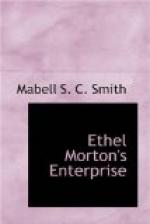“‘Ob-ovate’, if it’s like the other ob,” guessed Dorothy.
“The leaflets that make up the horse-chestnut leaf are ‘wedge-shaped’ at the base,” Helen reminded them.
“Then there are some leaves that have nothing remarkable about their tips but have bases that draw your attention. One is ’heart-shaped’—like the linden leaf or the morning-glory. Another is ‘kidney-shaped’. That one is wider than it is long.”
[Illustration: Shield-shaped Oblancolate
Spatulate
Rotund
Crenate
Edge]
[Illustration: Heart-shaped Kidney-shaped]
“The hepatica is kidney-shaped,” remarked James.
“The ‘ear-shaped’ base isn’t very common in this part of the world, but there’s a magnolia of that form. The ‘arrow-shaped’ base you can find in the arrow-weed in the brook. The shape like the old-time weapon, the ‘halberd’ is seen in the common sorrel.”
“That nice, acid-tasting leaf?”
“Yes, that’s the one. What does the nasturtium leaf remind you of?”
“Dicky always says that when the Jack-in-the-Pulpit stops preaching he jumps on the back of a frog and takes a nasturtium leaf for a shield and hops forth to look for adventures,” said Roger, to whom Dicky confided many of his ideas when they were working together in the garden.
[Illustration: Arrow-shaped Ear-shaped Halberd-shaped]
“Dicky is just right,” laughed Helen. “That is a ‘shield-shaped’ leaf.”
“Do the tips of the leaves have names?”
“Yes. They are all descriptive—’pointed,’ ‘acute,’ ‘obtuse,’ ‘truncate,’ ‘notched,’ and so on,” answered Helen. “Did you notice a minute ago that I spoke of the ‘leaflet’ of a horse-chestnut leaf? What’s the difference between a ‘leaflet’ and a ’leaf’?”
“To judge by what you said, a leaflet must be a part of a leaf. One of the five fingers of the horse-chestnut leaf is a leaflet,” Della reasoned out in answer.
[Illustration: Obtuse Truncated Notched]
“Can you think of any other leaves that have leaflets?”
“A locust?”
“A rose?”
[Illustration: Pinnate Pinnate, tendrils
Locust
Leaf Sweet Pea Leaf]
“A sweetpea?”
The latter answer-question came from Roger and produced a laugh.
“All those are right. The leaves that are made up of leaflets are called ‘compound’ leaves, and the ones that aren’t compound are ‘simple.’”
“Most leaves are simple,” decided Ethel Brown.
“There are more simple than compound,” agreed Helen. “As you recall them do you see any resemblance between the shape of the horse-chestnut leaf and the shape of the rose leaf and anything else we’ve been talking about this afternoon?”




